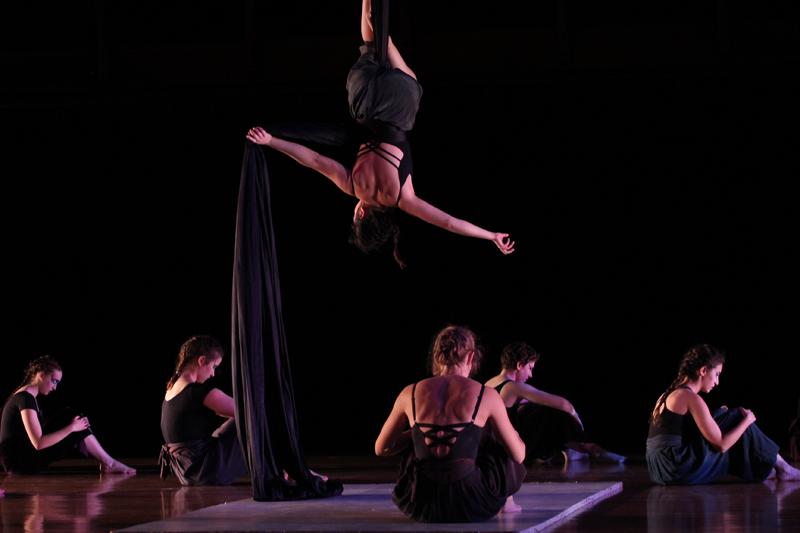Thrilling Performances and Choreography Elevate Senior Dance Concert
College senior Jessica Lam descends from above College sophomore Alana Reibstein, College junior Lillian White, College senior Jesse Wiener, College freshman Natalia Shevin and College senior Toby Irving during College senior Hayley Larson’s section of the Senior Dance Concert. The concert comprised Larson’s and fellow College senior Juliana Garber’s final projects in the Dance department.
February 28, 2014
The Senior Dance Concert this past Friday and Saturday in Warner Main was an absorbing representation of Oberlin’s Dance Department. Featuring choreography by two senior Dance majors, the show was a creative production that combined elements of partnering, aerial acrobatics and contact improvisation techniques, demonstrating a broad skill base. The Senior Dance Concert was performed on a modified proscenium-style stage, and as with most Oberlin dance shows, the performance was greatly enhanced by the open nature of the venue. The diverse, artistic dances demonstrated the capacity for experimentation in movement and structure in Oberlin’s Dance program and thoroughly enthralled the audience.
The opener “dis/connect” was choreographed by veteran performer and choreographer Juliana Garber, who most recently performed in the 2013 Fall Forward concert. Garber opened the piece with a fluid solo that harnessed a sense of suspension and contraction, a theme that she continued throughout the piece. Along with the other six dancers in the piece, Garber generated harmonic movement that was both inventive and truly beautiful. Each of the dancers moved with strong clarity — even their facial expressions evinced their engagement with the choreography. College senior Elaine Liu’s mid-dance entrance was particularly striking, adding another level of dimension to the dance. College juniors Christopher McLauchlan and Madeline Klein’s sheer strength as fully engaged dancers was similarly beautiful. They effortlessly connected with Garber’s choreography, and both demonstrated an acute awareness of bodily suspense and release — in other words, “dis/connecting.” Garber’s utilization of the famed Oberlin contact improvisation technique captured the ephemeral nature of connection and disconnection through the imagery of weight transfer and partnering. Additionally, her costume and lighting choices demonstrated a particularly mellow elegance, though the music was distracting at times.
In keeping with the name of her piece, Garber seemed to have a personal connection with her dance. The dancers had their own moments on stage to interpret Garber’s choreography, but Garber also had solos that captured her personal intent as a dancer. This interesting choreographic choice evoked feelings of reflection and separation, fitting for a final project performed not long before its creator will disconnect physically from Oberlin.
While Garber’s piece offered a more traditional and streamlined reflection on her Oberlin dance experience, Hayley Larson’s piece “Compress, Release” was more experimental, filled with quirky flare and presentational elements. The overall impression of Larson’s performance was less of a pure dance performance and more an intense hybrid of contemporary dance and Cirque du Soleil, a comparison aided by the use of extreme makeup and tight black costumes. While the piece was slightly disjointed, the disjointedness was generally entertaining and for the most part worked to the dance’s advantage. At times, the title seemed particularly appropriate. The opening solo focused on contrasting the elasticity of back-and-forth movement with the tension of stillness. While the dance began as a cohesive piece with a relatively small group, the addition of several other dancers created a sense of chaos on stage. The choreography was crafted with a clear sense of style and plenty of innovation, but lost some of its elegance due to the disorder caused by the amount of dancers onstage.
Larson’s use of aerial work was also intriguing. The incorporation of another art form was brave and exciting, especially in the context of such a complex, multi-dimensional dance. While many exciting aerialist performances take place at Oberlin, this particular experience was unique. While the incorporation of aerialist work was creatively choreographed and well-executed, at times the acrobatic silk routine struggled to mesh with the contemporary elements of the dance. Fortunately, this slight disjunction was redeemed by the originality and excitement otherwise demonstrated in the aerial segments.
The Senior Dance Concert should serve as an inspiration to all current and aspiring dancers. The innovation of movement, commingling of art forms, and choreography were exceptional, and the show was elevated by the investment and engagement of the dancers. During one of the most memorable moments of Larson’s piece, College sophomore Sakina Lavingia stood at the front of a large group of dancers, her eyes radiating a ferocity that was indicative of the sheer joy that dance at Oberlin brings to all involved — not only in Garber’s and Larson’s pieces, but in the program as a whole.
























